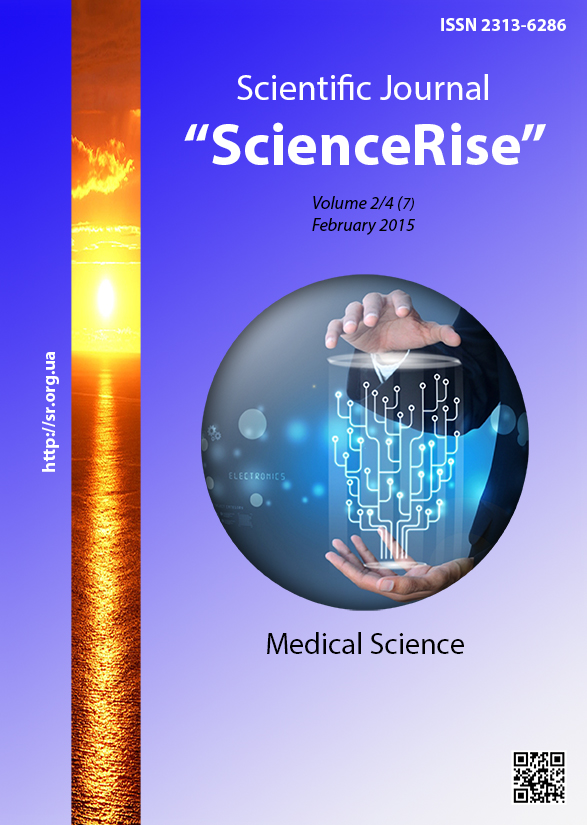Changes in pulmonary tissue because of esophageal achalasia. clinical case
DOI:
https://doi.org/10.15587/2313-8416.2015.38158Keywords:
esophageal achalasia, pulmonary tuberculosis, clinical case, treatment of tuberculosis, aspiration pneumoniaAbstract
Esophageal achalasia is a disease of unknown etiology, accompanied by the motility disorder, which leads to the esophageal food impaction. According to statistics, the incidence of esophageal achalasia is only 1 case per 100 000 population. Despite the fact that the disease is quite rare, physician-pulmonologist still meets such patients in the practice. At night, aggressive gastric contents in patients with esophageal achalasia can enter the respiratory tract, causing mostly aspiration pneumonia, less often - pulmonary tuberculosis. Features of treatment of pulmonary tuberculosis with esophageal achalasia are under-investigated, the problem is urgent.
Objective: to analyze the characteristics of pulmonary tuberculosis in patients with esophageal achalasia, to optimize the treatment regimens for such patients.
Methods: from 2008 to 2012, we observed 4 cases of esophageal achalasia patients with pulmonary disease as a complication. All patients had recurrent pneumonia. One patient with a history of frequent pneumonia had pulmonary tuberculosis.
Result: treatment of pulmonary tuberculosis with concomitant esophageal achalasia is difficult in some cases because of the food impaction in the gastrointestinal tract. As a result, a standard regimen of tuberculosis treatment by oral drugs may be ineffective, and parenteral or intramuscular administration of antituberculosis drugs is recommended in this case.
Conclusion: injection of anti-TB drugs is mainly recommended for pulmonary tuberculosis patients with concomitant esophageal achalasia
References
Vasilenko, V. H. (Ed.) (1964). Bolezni zheludka, kishechnika i brjushiny. Sofija: Medicina i fizkul'tura, 784.
Mayberry, J. F., Rhodes, J. (1980). Achalasia in the City of Cardiff from 1926 to 1977. Digestion, 20 (4), 248–252. doi: 10.1159/000198446
Mayberry, J. F., Atkinson, M. (1985). Studies of incidence and prevalence of achalasia in the Nottingham area. Q J Med., 220 (56), 451–456.
von Rahden, B. H., Filser, J., Seyfried, F. et al. (2014). Diagnostics and therapy of achalasia. Chirurg, 85 (12), 1055–1063. doi: 10.1007/s00104-014-2803-1
Vasilenko, V. X., Suvorova, T. A., Grebenev, A. L. (1976). Ahalazija kardii. Moscow: Medicina, 280.
Barajas-Fregoso, E. M., Romero-Hernández, T., Sánchez-Fernández, P. R. et al. (2015). Experience of the surgical management of the esophageal achalasia in a tertiary care hospital. Rev Med Inst Mex Seguro Soc., 53 (11), 84–91.
Sheptulin, A. A., Truhmanov, A. S. (1998). Novoe v diagnostike i lechenie gastrojezofagal'noj bolezni i ahalazii kardii. Klin. med., 5, 15–19.
Vela, M. F. (2014). Management strategies for achalasia. Neurogastroenterology & Motility, 26 (9), 1215–1221. doi: 10.1111/nmo.12416
Yasawy, M. I. (2014). Diagnosis and treatment of achalasia patients: a ten-year review of the clinical features. Hepatogastroenterology, 61 (134), 1611–1616.
Ivashkina, V. T., Lapinoj, T. L. (Eds.) (2011). Gastrojenterologija. Nacional'noe rukovodstvo: kratkoe izdanie. Moscow: GJeOTAR-Media, 480.
Layton, J., Ward, P. W., Miller, D. W., Roan, R. M. (2014). Acute respiratory failure secondary to esophageal dilation from undiagnosed achalasia. A A Case Rep., 3 (5), 65–67.
Hirata, M., Kohno, K., Murakami, S. et al. (2002). A case of recurrent aspiration pneumonia by achalasia. Nihon Kokyuki Gakkai Zasshi, 40 (2), 149–153.
Downloads
Published
Issue
Section
License
Copyright (c) 2015 Александр Алексеевич Ляшенко

This work is licensed under a Creative Commons Attribution 4.0 International License.
Our journal abides by the Creative Commons CC BY copyright rights and permissions for open access journals.
Authors, who are published in this journal, agree to the following conditions:
1. The authors reserve the right to authorship of the work and pass the first publication right of this work to the journal under the terms of a Creative Commons CC BY, which allows others to freely distribute the published research with the obligatory reference to the authors of the original work and the first publication of the work in this journal.
2. The authors have the right to conclude separate supplement agreements that relate to non-exclusive work distribution in the form in which it has been published by the journal (for example, to upload the work to the online storage of the journal or publish it as part of a monograph), provided that the reference to the first publication of the work in this journal is included.

